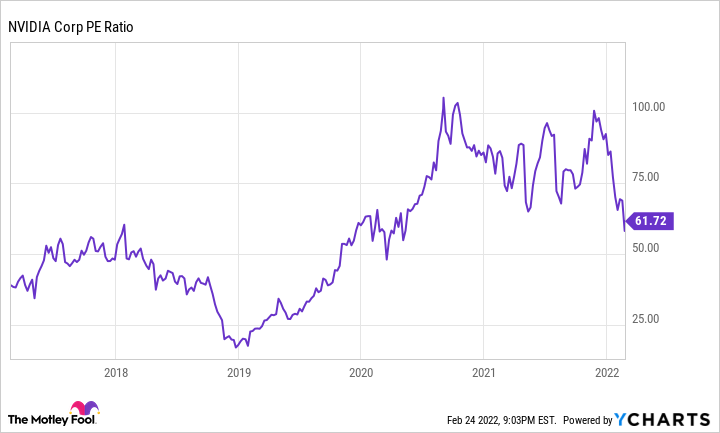$NVIDIA Corp(NVDA)$ has been one of the hottest stocks on Wall Street over the past few years. Before the recent sell-off, it was up over 1,200% over the last five years and nearly 750% over the past three. But the stock has been hammered recently and has given up some of those returns.
Now, with shares down more than 25% from their high, investors might be worried about the company's future. The stock dropped after the companies most recent earnings call despite reporting great numbers and strong guidance. With industry tailwinds at its back, is now the time to purchase the stock?
Two divisions are driving Nvidia's growth
Nvidia has multiple segments, but two stand out above the rest. Of the $7.6 billion Nvidia brought in during the fourth quarter, 45% and 43% were from its gaming and data center divisions, respectively. Nvidia's primary products are graphics processing units (GPUs), which handle intensive calculations and renderings pertaining to graphics seen on a screen.
By pretty much all measures, Nvidia makes the most powerful and desirable GPUs in the gaming industry. Its primary rival, $AMD(AMD)$ has great products but doesn't edge out Nvidia. A quick online search for the best gaming GPUs will provide many lists ranking Nvidia's products at the top. Its gaming segment sales were up 37% year over year, and it launched multiple new products in the quarter.
And GPUs are not just useful for graphics. Because they can process calculations efficiently, they can be used for data centers andcryptocurrency mining. While the base concept is the same, GPUs are designed differently for their intended use, whether it is for games or data centers.
Data centers are becoming more prominent as businesses power cloud offerings with them. The uses for Nvidia's data center technology are numerous, and during the quarter, it was involved in multiple accomplishments with some of the biggest names in tech. $Meta Platforms, Inc.(FB)$ selected Nvidia's DGX A100 system to build its AI Research SuperCluster, Nvidia set workload speed records with $Microsoft(MSFT)$ Azure, and Stanford researchers set a world record by mapping the human genome in 7 1/2 hours with Nvidia GPU's on $Alphabet(GOOG)$ Google Cloud.
With the transition to the cloud, this segment has been on fire, and it grew 71% during the quarter while only rising 58% for the full fiscal year. With the end-of-the-year surge, the business unit will look to carry momentum into the next year. During its fourth-quarter conference call, management noted its 2023 first-quarter growth will be driven by its data center division, with gaming contributing to a lesser extent. Revenue guidance was $8.1 billion, setting up Nvidia to report another impressive quarter with projected growth of 43%.
A high but attractive valuation
Over the past two years, Nvidia has never been a cheap stock. Itsprice-to-earnings(P/E) ratio hasn't dipped below 60 since the pandemic's onset. Prior to that, Nvidia traded at a P/E between 35 and 50. Why has its valuation increased so much within the past two years?
It all comes down to business execution and opportunity. In 2018, the company was levered toward crypto mining, and when those assets crashed in 2019, Nvidia was left with a large inventory of unwanted GPUs -- which sunk the stock price but didn't touch earnings.
After purging its supply and improving its financial status, the company received a huge pandemic-driven boost when gaming PCs were a must for those who were isolated but still wanted to connect with friends and strangers alike. Businesses also had to improve their cloud capabilities, which further boosted Nvidia's finances.
While the gaming catalyst is subsiding, the data center boom is just beginning. This will likely provide years of growth for Nvidia. Additionally, it has two divisions with massive upside potential. Its professional visualization division was up 109% year over year to $643 million and includes Nvidia's Omniverse, known as the metaverse for engineers. It also has an automotive segment with self-driving technology, although this business portion was down 14% year over year due to manufacturers not producing as many vehicles because of supply constraints.
A 60 P/E price tag isn't cheap, but with a business growing revenue andearnings per share(EPS) at 53% and 103%, respectively, in a quarter, it isn't too expensive, either. Throw in industry tailwinds like data centers, Omniverse collaboration, and self-driving cars, and Nvidia's valuation begins to look somewhat cheap when examined from a long-term shareholder perspective.
One of the primary reasons I haven't purchased Nvidia stock for myself is its valuation. With its near 30% drawdown and reduced valuation, I may finally add the stock to my portfolio. Still, even if I had bought Nvidia at its peak 105 P/E during September 2020, I'd still be up over 120% today.
Valuation isn't everything when assessing a stock, a lesson Nvidia has taught me. If the future is bright enough and the business executes well, then valuation becomes almost irrelevant over long holding periods. Nvidia is a great buy. Investors willing to take on some volatility would be wise to take advantage of the lower price to own one of the most innovative public companies today.
source: The Motley Fool

Comments